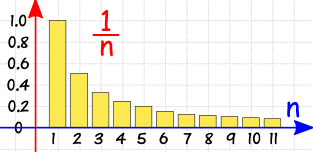Convergence of Sequences

Definition of Convergent

Convergence of a Sequence of Numbers.
Before discussing convergence for a sequence of random variables, let us remember what convergence means for a sequence of real numbers.
Let's explain convergence of a sequence with an example:
Consider the sequence defined as follows:
aₙ = 1/n, where n = 1, 2, 3, ...
Let's list the first few terms of the sequence:
a₁ = 1/1 = 1
a₂ = 1/2 = 0.5
a₃ = 1/3 ≈ 0.333...
a₄ = 1/4 = 0.25
a₅ = 1/5 = 0.2
...
As we can see, each term of the sequence is the reciprocal of the natural number 'n.' The terms of the sequence get smaller and smaller as 'n' increases, since we are dividing 1 by an increasing natural number.
Now, let's see if this sequence converges and find its limit (if it exists).
To show convergence, we need to demonstrate that as we progress further along the sequence, the terms get arbitrarily close to a fixed value, which we'll call 'L.'
Let's take any positive value ε (epsilon), for example, ε = 0.1. We want to find a point in the sequence (index N) after which all the subsequent terms are within 0.1 units of the limit 'L.'
Now, we solve for N in the inequality |aₙ - L| < ε:
|1/n - L| < 0.1
Since we want the difference between 'aₙ' and 'L' to be less than 0.1, we can set:
1/n - L < 0.1
or
L - 1/n < 0.1
Let's consider the second inequality:
L - 1/n < 0.1
To make L - 1/n smaller than 0.1, we can set L = 0.1. Now we have:
0.1 - 1/n < 0.1
Simplifying:
-1/n < 0
Since n is a positive natural number, -1/n will always be negative. So, the above inequality holds for all n.
Now, consider the first inequality:
1/n - L < 0.1
Substitute L = 0.1:
1/n - 0.1 < 0.1
Simplifying:
1/n < 0.2
Now, find the smallest value of 'n' for which the above inequality holds:
n > 1/0.2
n > 5
Thus, for any ε = 0.1, we have found N = 6, such that for all n ≥ N (i.e., n ≥ 6), the inequality |aₙ - L| < ε holds.
So, we can conclude that the sequence aₙ = 1/n converges to the limit L = 0.1. As we progress further along the sequence, the terms get arbitrarily close to the limit value of 0.1. This means that the terms of the sequence 1, 0.5, 0.333..., 0.25, 0.2, ... converge to 0.1 as 'n' becomes larger and larger.